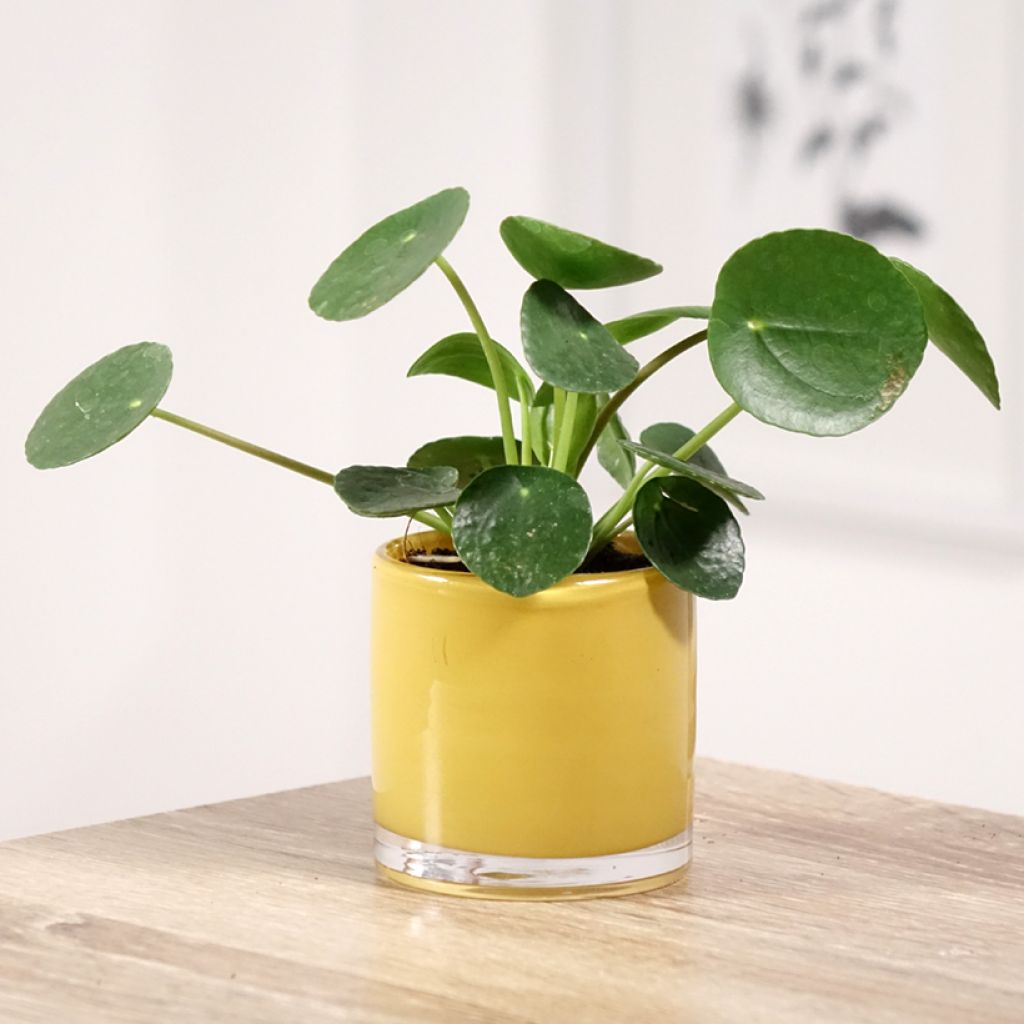

Chinese money plant - Pilea peperomioides


Chinese money plant - Pilea peperomioides


Chinese money plant - Pilea peperomioides


Chinese money plant - Pilea peperomioides


Chinese money plant - Pilea peperomioides


Chinese money plant - Pilea peperomioides


Chinese money plant - Pilea peperomioides


Chinese money plant - Pilea peperomioides


Chinese money plant - Pilea peperomioides


Chinese money plant - Pilea peperomioides
Chinese money plant - Pilea peperomioides
Pilea peperomioides
Chinese money plant
I understand you're ready to proceed, but I don't see any customer review text to translate. Could you please provide the customer feedback you'd like me to translate into English?
sawi, 30/09/2025
Special offer!
Receive a €20 voucher for any order over €90 (excluding delivery costs, credit notes, and plastic-free options)!
1- Add your favorite plants to your cart.
2- Once you have reached €90, confirm your order (you can even choose the delivery date!).
3- As soon as your order is shipped, you will receive an email containing your voucher code, valid for 3 months (90 days).
Your voucher is unique and can only be used once, for any order with a minimum value of €20, excluding delivery costs.
Can be combined with other current offers, non-divisible and non-refundable.
Home or relay delivery (depending on size and destination)
Schedule delivery date,
and select date in basket
This plant carries a 30 days recovery warranty
More information
We guarantee the quality of our plants for a full growing cycle, and will replace at our expense any plant that fails to recover under normal climatic and planting conditions.

Description
The Pilea peperomioides is a highly popular species in recent years for its graphic appearance, and it is also low-maintenance. Its look is striking, with perfectly round leaves that earn it the name 'Pancake Plant' among English speakers. They are held by long petioles from a main stem that lengthens year after year, lifting this aerial water lily higher and higher. Provide it with well-drained soil and a very bright position. It enjoys morning or late afternoon sunlight. If the growth seems uneven, turn the pot around regularly.
The Pilea peperomioides is also called Chinese Money Plant and Pancake Plant. It originates from southern China. It belongs to the Urticaceae family, like the stinging nettle... but without the sting. The Pilea genus includes over 600 species, native to tropical and subtropical regions of Asia, Africa, and the Americas. The species develops a rigid, upright stem about 1 cm thick which browns and becomes lignified at the base over time. As they age, the lower leaves fade, turn yellow, and then fall, revealing a small dark trunk marked with foliar scars. This stem bears alternate, fleshy leaves, with a lamina shaped like a broad disc averaging 10 cm, sometimes up to 15 cm. These spaced-out leaves are supported by long, rigid petioles. This pilea can reach up to 50 cm in height, or even 80 cm in some cases. With its round, glossy leaves, it bears a resemblance to the Peperomia polybotrya, hence its name.
The Pilea peperomioides is a beautiful plant unique in its kind, which one happily displays at home and which is easy to propagate with cuttings to create more young plants to share with loved ones. Over time, with its moderate to fairly rapid growth, it forms an attractive graphic specimen, a voluminous and easy-to-care-for plant, highly resistant to parasites. Place it alongside succulents or near a cactus—it will fit perfectly in both settings.
Report an error about the product description
Chinese money plant - Pilea peperomioides in pictures






Foliage
Plant habit
Botanical data
Pilea
peperomioides
Urticaceae
Chinese money plant
China, South America
Location
Location
Maintenance and care
Watering tips
Potting advice, substrates and fertilisers
Houseplant care
Disease and pest advice
Maintenance and care
-
, onOrder confirmed
Reply from on Promesse de fleurs
Haven't found what you were looking for?
Hardiness is the lowest winter temperature a plant can endure without suffering serious damage or even dying. However, hardiness is affected by location (a sheltered area, such as a patio), protection (winter cover) and soil type (hardiness is improved by well-drained soil).

Photo Sharing Terms & Conditions
In order to encourage gardeners to interact and share their experiences, Promesse de fleurs offers various media enabling content to be uploaded onto its Site - in particular via the ‘Photo sharing’ module.
The User agrees to refrain from:
- Posting any content that is illegal, prejudicial, insulting, racist, inciteful to hatred, revisionist, contrary to public decency, that infringes on privacy or on the privacy rights of third parties, in particular the publicity rights of persons and goods, intellectual property rights, or the right to privacy.
- Submitting content on behalf of a third party;
- Impersonate the identity of a third party and/or publish any personal information about a third party;
In general, the User undertakes to refrain from any unethical behaviour.
All Content (in particular text, comments, files, images, photos, videos, creative works, etc.), which may be subject to property or intellectual property rights, image or other private rights, shall remain the property of the User, subject to the limited rights granted by the terms of the licence granted by Promesse de fleurs as stated below. Users are at liberty to publish or not to publish such Content on the Site, notably via the ‘Photo Sharing’ facility, and accept that this Content shall be made public and freely accessible, notably on the Internet.
Users further acknowledge, undertake to have ,and guarantee that they hold all necessary rights and permissions to publish such material on the Site, in particular with regard to the legislation in force pertaining to any privacy, property, intellectual property, image, or contractual rights, or rights of any other nature. By publishing such Content on the Site, Users acknowledge accepting full liability as publishers of the Content within the meaning of the law, and grant Promesse de fleurs, free of charge, an inclusive, worldwide licence for the said Content for the entire duration of its publication, including all reproduction, representation, up/downloading, displaying, performing, transmission, and storage rights.
Users also grant permission for their name to be linked to the Content and accept that this link may not always be made available.
By engaging in posting material, Users consent to their Content becoming automatically accessible on the Internet, in particular on other sites and/or blogs and/or web pages of the Promesse de fleurs site, including in particular social pages and the Promesse de fleurs catalogue.
Users may secure the removal of entrusted content free of charge by issuing a simple request via our contact form.
The flowering period indicated on our website applies to countries and regions located in USDA zone 8 (France, the United Kingdom, Ireland, the Netherlands, etc.)
It will vary according to where you live:
- In zones 9 to 10 (Italy, Spain, Greece, etc.), flowering will occur about 2 to 4 weeks earlier.
- In zones 6 to 7 (Germany, Poland, Slovenia, and lower mountainous regions), flowering will be delayed by 2 to 3 weeks.
- In zone 5 (Central Europe, Scandinavia), blooming will be delayed by 3 to 5 weeks.
In temperate climates, pruning of spring-flowering shrubs (forsythia, spireas, etc.) should be done just after flowering.
Pruning of summer-flowering shrubs (Indian Lilac, Perovskia, etc.) can be done in winter or spring.
In cold regions as well as with frost-sensitive plants, avoid pruning too early when severe frosts may still occur.
The planting period indicated on our website applies to countries and regions located in USDA zone 8 (France, United Kingdom, Ireland, Netherlands).
It will vary according to where you live:
- In Mediterranean zones (Marseille, Madrid, Milan, etc.), autumn and winter are the best planting periods.
- In continental zones (Strasbourg, Munich, Vienna, etc.), delay planting by 2 to 3 weeks in spring and bring it forward by 2 to 4 weeks in autumn.
- In mountainous regions (the Alps, Pyrenees, Carpathians, etc.), it is best to plant in late spring (May-June) or late summer (August-September).
The harvesting period indicated on our website applies to countries and regions in USDA zone 8 (France, England, Ireland, the Netherlands).
In colder areas (Scandinavia, Poland, Austria...) fruit and vegetable harvests are likely to be delayed by 3-4 weeks.
In warmer areas (Italy, Spain, Greece, etc.), harvesting will probably take place earlier, depending on weather conditions.
The sowing periods indicated on our website apply to countries and regions within USDA Zone 8 (France, UK, Ireland, Netherlands).
In colder areas (Scandinavia, Poland, Austria...), delay any outdoor sowing by 3-4 weeks, or sow under glass.
In warmer climes (Italy, Spain, Greece, etc.), bring outdoor sowing forward by a few weeks.





























